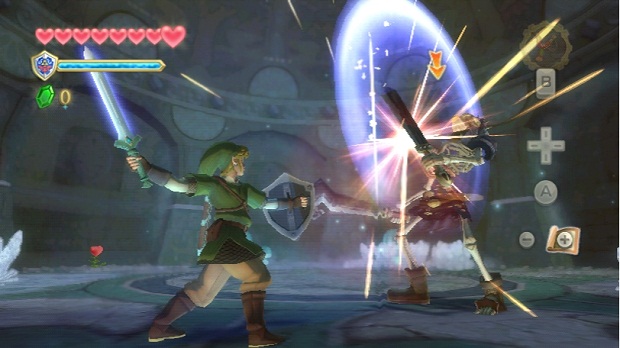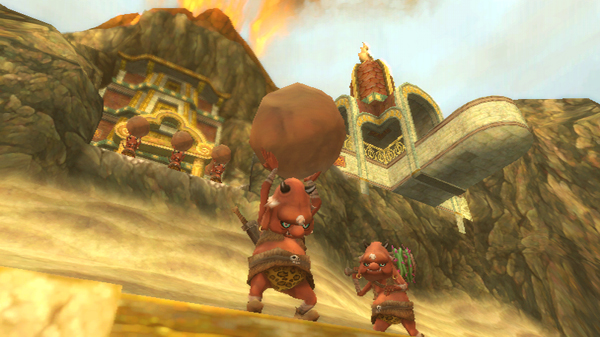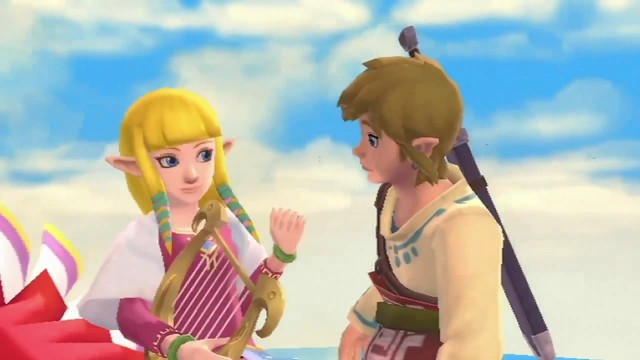Advances the traditional Zelda formula, outstanding visuals, Wii MotionPlus sword play at its finest, seamless menu navigation, top-notch level design.
Slightly patronising at times, repetitious backtracking, a weaker story than previous Zelda games.
The signs were there from the beginning. Six hearts; strict instructions to equip myself with both a shield and a potion– all for only my first fearless skydive down to the fabled surface land. Having just learned to soar through the skies on my crimson Loftwing, Fi’s hefty list of pre-dungeon preparations seemed a little over zealous.
Two broken shields and two empty bottles later though, and I felt sufficiently humbled and humiliated. As Link finally staggered away from his first encounter with Lord Ghirahim, I realised I had grossly underestimated just what kind of adventure Skyward Sword would have in store for me, and it was clear from that moment on that this would be a very different type of Zelda game indeed.
You only really need to look at the finer mechanics of Skyward Sword to appreciate how far the Zelda series has come since Link’s last outing on Wii. Link now sports a stamina meter and will tire quickly if he sprints too far or performs one too many spin or jump attacks. His shield can only endure so much pain and torture, and a limited number of adventure pouches means he can no longer carry every single bottle or item upgrade that comes his way. He can err on the side of caution by choosing survival options or throw said caution to the wind by loading himself up with extra bomb bags and deku seed pouches, but our hero is no longer the boy who’s prepared for everything. Strategy is now the name of the game.
He must also learn how to pick his fights, but the combat is so sublime that you’ll want to challenge everything that stands in your way. This is easily Wii MotionPlus at its finest, and using a bomb flower has never been such an art form. Enemies are now exponentially more intelligent, and will block, parry and strike you down if you’re too slow when they open their weak spots. Although your sword movements are limited to eight directions (up, down, across and diagonally), this is more than enough to handle when you’re trying to fend off a four-sword wielding stalfos. It’s no longer a case of swinging your sword wildly in desperation and spin-attacking everything that moves to get the job done quickly; each swing must be carefully timed and calculated, and each individual skirmish has never been more engaging.

Mindless foes are now a thing of the past and you’ll need every one of those six hearts when you first start your adventure.
Moreover, never again will you have to pause the game to switch items. All this can be done completely on the fly in real time, giving Link unprecedented access to his wide arsenal of weapons. It’s even more versatile than Ocarina of Time 3D’s menu system, and whipping out my bow for a last minute bullseye or reaching for a much-needed potion has never been so easy or indeed so satisfying.
Its bright and colourful art style is similarly stunning, a perfect marriage of The Wind Waker’s picturesque charm and the darker hues ushered in by Twilight Princess. This is a Hyrule brimming with life and expression, a raw, organic environment whose forests twist and turn like living tree roots, a wide, sprawling desert ocean stretches as far as the eye can see, and hot lava bubbles up underfoot as it moves sluggishly round the towering Eldin Volcano. It’s a world where animated shopkeepers actively vie for your attention in the local bazaar only to sigh and drop their shoulders in defeat as you stroll on by, where bokoblins sound their horns to gather their comrades, and where one young man will go to the ends of the earth for the girl he loves.
Yet underneath Skyward Sword’s cheerful exterior lies an unnerving eerieness that rivals the unsettling undercurrents of Majora’s Mask, helping it to achieve a much more rounded adult sensibility. The opening cinematic sets the tone immediately, and Link’s vivid nightmares of The Imprisoned are decidedly sinister considering the more uplifting tapestry of colours which frame the world around him. Likewise, Lord Ghirahim is morbidly frank despite his flamboyant disposition, and the Silent Realms which feature later on in the story play host to some of the most tense and ominous moments of the entire game, capturing the same uncanny atmosphere of the twilight in Twilight Princess with expert precision.
Skyward Sword’s greatest achievement though is that it very nearly succeeds in eliminating the word “dungeon” from the Zelda formula. You still have traditional dungeons, now marked by an added sense of gravitas when Link first descends into their murky depths, but I wouldn’t be able to pin down an exact number simply because every moment you spend outside is as much a dungeon as the one that came before. Ingenious puzzles and handy shortcuts litter each of the three main areas and you’re consistently rewarded for your efforts with such important items that you’re never sure where one dungeon ends and the next one begins. It’s a fantastic evolution, and the variety and sweeping scope of the unfolding landscape keeps engagement and motivation levels high during sometimes lengthy bouts of exploration. Reaching your final destination now feels just as much an accomplishment as dealing the final blow in one of the many outstanding boss battles.

When each area is so tightly guarded it’s sometimes difficult to remember they’re not dungeons themselves.
However, for all Skyward Sword’s leaps and bounds, there are also places where it stumbles and trips over its own efforts to innovate. While the seamless transition between dungeons reinvigorates Zelda’s classic structure, the decision to divide Hyrule into three main sections ultimately leaves each area feeling completely dislocated from its surroundings. It’s no longer one open, joined up environment, and this brings with it both positive and negative results. The sedate village of Skyloft itself acts as your main hub-like structure, and to reach the realms of Faron, Eldin and Lanayru you must fly toward one of three portals in the clouds. Although this panders to the story’s idea of a disconnected land and sky, it constantly feels like you’re being forced to travel two sides of a triangle. The story itself doesn’t require you to zip back and forth between them too often, but Link’s Loftwing doesn’t exactly move along at any great pace. Each time you want to undertake a sidequest or feel like a change of scenery, you’ve no choice but to take to the heavens and begin the leisurely jaunt over to the next portal. Appropriately placed slipstreams help alleviate the burden of travel, but overall it lacks the ease and convenience of previous Zelda transportation systems.
That said, Skyward Sword does rescue itself slightly from this flaw by letting you choose from a series of checkpoint locations where you can land once you’ve finally arrived at each portal. These help enormously when you come to revisit each area, and it cuts down the amount of backtracking involved much more effectively than previous musical teleportation points.
However, there’s almost a tendency for it to be too helpful, as it repeatedly patronises the player when you pick up an enemy treasure or catch bugs. You might already have 20 lizard tails in your inventory, but apparently you still need another explanation and an excrutiatingly slow process of having it placed it in the menu for you each time you pick up a new one for the first time whenever you load up your game. It’s irritating and completely unnecessary, and considering there’s sixteen treasures and twelve bugs on offer, that’s a lot of repetitive messages to sit through.
That same feeling of tired repetition also creeps in during the later arcs of the game when Link must return to each location multiple times, with the third arc in particular falling dangerously close to feeling downright contrived. But Skyward Sword must be applauded for the way it attempts to brighten up the chore of backtracking. It adopts a Super Mario Galaxy-esque approach where each major visit confronts you with a new scenario by changing the area’s landscape or accessible areas, so the time actually spent traversing the same old paths is relatively minimal. Not only do the monsters level up alongside you as well, so to speak, but Fi’s dowsing mechanism also helps to seek out precisely what you want without too much aimless wandering. In fact it’s not so much the backtracking itself which feels repetitious, but rather the story objectives which really cast a shadow over these otherwise perfectly enjoyable and well-crafted sections of the game. The third arc’s main objective is certainly the most ridiculous task Link has had the misfortune to endure to date, and it’s this which heavily contributes to making the backtracking feel laboured and ever so slightly lazy.

As a force of narrative desire, Link and Zelda’s relationship isn’t quite robust enough to carry the first half of the game all on its own.
Fundamentally it’s therefore the story which lets Skyward Sword down the most. It’s opening hours are painstakingly slow, and it’s sorely lacking in some of the narrative drive that previous Zelda titles have mastered so well. It’s perhaps unsurprising that your main objective is once again to save Zelda, but you’re never really told why she’s in danger or why she too is embarking on her own journey of self-discovery and purification. This means your subsequent objectives during the course of the game lose some of their original purpose, and while the adventure and ensuing dungeons keep the momentum flowing, you’re ultimately left wondering why you’re there in the first place. Traditional story-revelation points like after the climax of the third dungeon came and went without so much as even a glimmer of who the real villain is or what the ultimate end game might entail, and the lengthy middle arc of the game means it’s a very long time before you get any closure. The care taken to establish Link and Zelda’s genuinely touching relationship is obviously meant to be enough to sustain a player’s interest, but 25 hours is far too long to keep your audience in the dark about the rest of the story.
The hotly touted RPG elements also feel superfluous. Using materials to customise my shield and increase the power of my bow was fun but none of the upgrades ever felt like they were wholly necessary purchases or integral to advancing through the story. The entire upgrade system lacks the depth and complexity to make it relevant or revolutionary in any meaningful way, and while stronger items certainly come in handy when tougher, more powerful sets of monsters muscle in on the action, your standard equipment can serve you perfectly well throughout the game.
In sum, Skyward Sword is truly one of the finest Wii games, but there are too many conflicting factors to make it the very best. Much like its main theme, The Ballad of the Goddess, Skyward Sword is a love-letter to Zeldas past, combining everything we know and love about the series (toilet-paper sidequests and all) while simultaneously reworking them to create an entirely unique and engaging experience, albeit with only partial success. The moments where the odd discordant cadence make us yearn for times gone by come a little too often, even though it’s by far the greatest testimony and most successful game to fulfil the promise of one-to-one motion control. It’s an apt swan song for our little white console, but ultimately it’s flown a little too close to the sun.




 ShareThis
ShareThis







I’ve not actually read the review because I am going to try and save myself until I’ve got the time to buy/play Skyward Sword but I just wanted to say that the masthead artwork is absolutely stunning.
I’m such a sucker for pretty pictures *le sigh*
(PS – Excellent job on getting this review out so quickly Katharine, you’re fab!)
Wow, i didnt expect such a negative review, i haven’t played the game yet, but i have read all the reviews available, you said that the beginning of the game is very slow, but rich and audrey from ign said it was fast, fun and that the game has an incredible passing. From what ive seen the story and the cinemas look pretty epic, but you said that the story is weaker this time. Anyway , i,m very exited for this game ( 1998 pre-ocarina excitement type) and already buy it like a month ago, but since i live in colombia, is gonna take a while before i can play it.
The thing is , i know that you are a zelda fan, so you probably have a good judgement on this game, should i be worried about the negative points of this game? Hope not.
I’m sorry if i write something wrong, but english is not my native language.
I actually thought it was fairly positive! I think with reviews of Zelda games people will usually compare them with other Zelda games, which already disadvantages the new Zelda– after all, they gotta live up to some very, very heroic stock. Besides, an A- ain’t so bad ;)
Hope you get to play it soon!
I don’t think you should be too worried, hence the still relatively high score, but just don’t expect it to be the greatest Zelda game ever.
My main issue with the beginning is that it takes roughly 60-90 minutes to get going – after that it’s fine and the action really starts to pick up. It’s just getting to that point that’s the problem. It’s definitely more enjoyable than Twilight Princess‘ opening fishing tutorial though, that’s for sure!
The story on the other hand gets somewhat drowned out by the lengthy exploration and dungeon-solving. As I mentioned in the review, the pacing and momentum is still great, but this is due partly to the construction of the dungeons, not the underlying plot and the reason why you’re there in the first place. If Zelda games always had a fairly flimsy plot like, say, Mario games, then I wouldn’t have an issue with it. But as their strong stories have always been part of their charm and appeal, at least for me, it’s something I feel which needs flagging up.
It’s definitely a game you should play and (hopefully!) enjoy, but it’s also not as perfect as the hype might lead you to believe. I hope that answers some of your concerns, and I hope you get to play it soon! :)
You know? I might just have to buy a Wii for this. ;)
One thing I love so far (I’m about 10 hours in) is the Skyloft residents. They feel so alive and fully formed for side characters. I can’t wait to learn more and more about ’em.
Definitely, I totally agree. I’d recommend taking a nap and seeing Skyloft at night – that’s when their real personalities come out :) Gondo the mechanic and the shop keeper guy are my favourites!
My favorite is that one girl in the knight outfit who gets angry at Link for not opening the door for her. Something about chivalry. How ironic.
Haha, yes, she’s definitely one of the best. I’m so glad this year’s knight uniform wasn’t yellow… I also love the fact that Link can just shrug off his sword and shield and commandeer anyone’s bed in this game! As if going into their houses/rooms and breaking all their pots wasn’t enough, now he’s going to sleep in their beds too! XD
I totally don’t agree with the story being a negative and the beginning being too slow. I thought that this was the best Zelda story yet with some of the best characters and best cut-scenes. The first half was executed flawlessly in the sense that it gave you reason to actually want to save Zelda and have you care for all the citizens of Skyloft(even Groose..!). This is the first Zelda game where I can say that I actually, truly care for Zelda and want to save her; she’s a great character this time around. But, of course, that is just my opinion. :P
I definitely agree that it has the best characters, cut-scenes, and by far the best version of Zelda in the entire series, but I think my main gripe was that the story didn’t quite have the same kind of power or oompf that other games have had. I felt it kind of got lost underneath all the dungeons, particularly in the second arc, and it just didn’t give Link the same kind of purpose as opposed to, say, Ganondorf taking over the world. I really loved their relationship, but I just would have liked a bit more impending doom looming on the horizon to make saving her even more pertinent :)